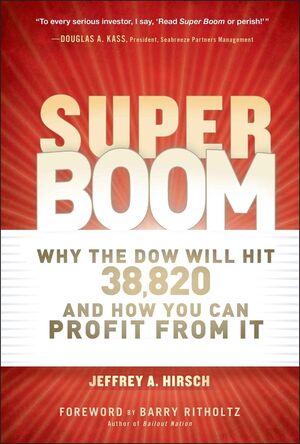Super Boom: Why the Dow Jones Will Hit 38,820 and How You Can Profit From ItISBN: 978-1-118-02470-6
Hardcover
208 pages
April 2011
 This is a Print-on-Demand title. It will be printed specifically to fill your order. Please allow an additional 10-15 days delivery time. The book is not returnable.
|
||||||
Connect with Wiley Publicity
Civil unrest in the Mideast and North Africa, as well as the disaster in Japan, have recently jacked up oil and energy prices. Crop disruptions over the past year and heightened demand from emerging markets have pushed commodity and food prices to record highs. Gold, silver and other precious metals remain elevated as global economic uncertainty persists and the U.S. dollar continues to be driven down by aggressively accommodative Fed policy. One of main central drivers of a super boom—an inflationary environment—is already on the horizon.
In his brand new book SUPER BOOM: Why the Dow Jones Will Hit 38,820 and How You Can Profit From It (Wiley; April 2011; $24.95; 978-1-118-02470-6; Hardcover), Stock Trader’s Almanac Editor-in-Chief Jeffrey A. Hirsch provides an in-depth analysis of his blockbuster super boom forecast introduced last October in the 44th annual edition of the Stock Trader’s Almanac.
In 1976, Stock Trader’s Almanac Founder Yale Hirsch predicted a 15-year super boom—a move in the stock market of 500% or more. His forecast was amazingly accurate as the market rose and continued upward, eventually posting a gain of 1,447% on the Dow Jones Industrials from the 1982 low to just before the tech crash in 2000. History has a way of repeating itself, especially in the financial markets.
Drawing on the bull’s-eye forecast of his predecessor, mentor, and father and incorporating his own knowledge of the inner workings of the stock market, long-term economic trends, and historical cycles, Jeff Hirsch shows how the Dow’s climb to 38,820 by the year 2025 from the Dow’s 2010 close of 11,577.51 is perfectly plausible. This climb represents a modest annual growth rate of 8.4% per year over 15 years. This is well within the range of long term average gains and even more attainable considering we are coming off the worst bear market in 80 years.
War & Peace + Inflation + A Secular Bull Market = 500% Market Moves
After examining other bold Dow predictions and why they didn’t pan out, Hirsch explores all the factors that contributed to the previous 500% moves that followed the three major wars of the 20th Century and how meteoric rises in stock indices are due to specific catalysts predominantly outside of the financial markets, including:
- Inflation: While it may be at bay for the time being, the massive injection of money by the government, in response to the global financial crisis and the Great Recession, as well as wartime spending, will eventually create an inflationary environment.
- Peace between major wars: Despite continuing violence in Iraq and Afghanistan, U.S. troop withdrawals remain on schedule, and military presence in these countries will be winding down over the next several years. Recent trouble in the Mideast is being handled multilaterally and is not expected to draw the U.S. into another protracted foreign military engagement.
- Secular bear markets: One thing is consistent now and during the previous three long-term busts or “secular” bear markets: the U.S. stock market has gone nowhere for a decade or more.
- New enabling technologies: While no one can say for sure where the next cultural paradigm-shifting technologies will come from, energy technology and/or biotechnology could lead the way.
“It’s that 70s Show again,” proclaims Hirsch. “Conditions are not identical to the long economic-maligned dark days of disco and polyester, but we are seeing several similarities. American families are being hit with a stealth stagflation in 2011. Food, energy, healthcare, and education inflation are sapping family resources as job and wage growth and the housing sector stagnate. Several parallels to the long flat markets and economies before the Roaring 1920s and during the Great Depression also exist.”
In addition to making a case for why the markets are poised for another super boom, Hirsch outlines potential opportunities for investing in a super boom, as well as a new trading strategy for maximizing returns in good or bad markets.
The American economy, and subsequently the world economy, has always existed in a cycle of boom and bust: gold, grain, oil, technology, and most recently, real estate, have all bubbled and popped. The key to investing profitably is spotting macroeconomic historical trends and positioning to reap the benefits. SUPER BOOM: Why the Dow Jones Will Hit 38,820 and How You Can Profit From It is an invaluable guide to prospering from the profitable opportunities that lie ahead.



